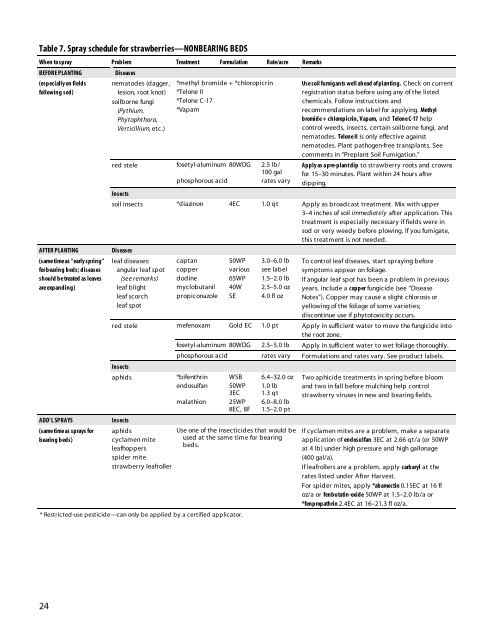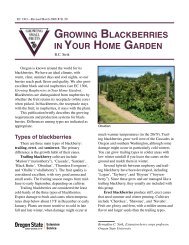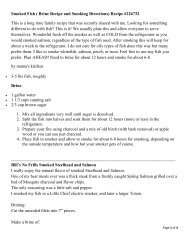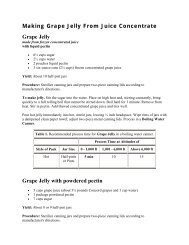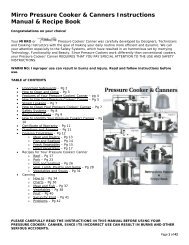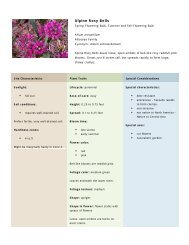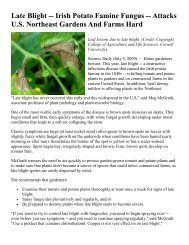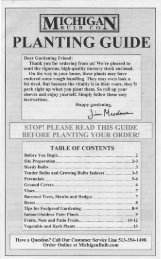Strawberry and Raspberry Pest Management in Wisconsin
Strawberry and Raspberry Pest Management in Wisconsin
Strawberry and Raspberry Pest Management in Wisconsin
You also want an ePaper? Increase the reach of your titles
YUMPU automatically turns print PDFs into web optimized ePapers that Google loves.
Table 7. Spray schedule for strawberries—NONBEARING BEDS<br />
When to spray Problem Treatment Formulation Rate/acre Remarks<br />
BEFORE PLANTING Diseases<br />
(especially on fields<br />
follow<strong>in</strong>g sod)<br />
24<br />
nematodes (dagger,<br />
lesion, root knot)<br />
soilborne fungi<br />
(Pythium,<br />
Phytophthora,<br />
Verticillium, etc.)<br />
*methyl bromide + *chloropicr<strong>in</strong><br />
*Telone II<br />
*Telone C-17<br />
*Vapam<br />
red stele fosetyl-alum<strong>in</strong>um 80WDG 2.5 lb/<br />
100 gal<br />
phosphorous acid rates vary<br />
Insects<br />
AFTER PLANTING Diseases<br />
(same time as “early spr<strong>in</strong>g”<br />
for bear<strong>in</strong>g beds; diseases<br />
should be treated as leaves<br />
are exp<strong>and</strong><strong>in</strong>g)<br />
Use soil fumigants well ahead of plant<strong>in</strong>g. Check on current<br />
registration status before us<strong>in</strong>g any of the listed<br />
chemicals. Follow <strong>in</strong>structions <strong>and</strong><br />
recommendations on label for apply<strong>in</strong>g. Methyl<br />
bromide + chloropicr<strong>in</strong>, Vapam, <strong>and</strong> Telone C-17 help<br />
control weeds, <strong>in</strong>sects, certa<strong>in</strong> soilborne fungi, <strong>and</strong><br />
nematodes. Telone II is only effective aga<strong>in</strong>st<br />
nematodes. Plant pathogen-free transplants. See<br />
comments <strong>in</strong> “Preplant Soil Fumigation.”<br />
Apply as a pre-plant dip to strawberry roots <strong>and</strong> crowns<br />
for 15–30 m<strong>in</strong>utes. Plant with<strong>in</strong> 24 hours after<br />
dipp<strong>in</strong>g.<br />
soil <strong>in</strong>sects *diaz<strong>in</strong>on 4EC 1.0 qt Apply as broadcast treatment. Mix with upper<br />
3–4 <strong>in</strong>ches of soil immediately after application. This<br />
treatment is especially necessary if fields were <strong>in</strong><br />
sod or very weedy before plow<strong>in</strong>g. If you fumigate,<br />
this treatment is not needed.<br />
leaf diseases:<br />
angular leaf spot<br />
(see remarks)<br />
leaf blight<br />
leaf scorch<br />
leaf spot<br />
captan 50WP 3.0–6.0 lb<br />
copper various see label<br />
dod<strong>in</strong>e 65WP 1.5–2.0 lb<br />
myclobutanil 40W 2.5–5.0 oz<br />
propiconazole SE 4.0 fl oz<br />
To control leaf diseases, start spray<strong>in</strong>g before<br />
symptoms appear on foliage.<br />
If angular leaf spot has been a problem <strong>in</strong> previous<br />
years, <strong>in</strong>clude a copper fungicide (see “Disease<br />
Notes”). Copper may cause a slight chlorosis or<br />
yellow<strong>in</strong>g of the foliage of some varieties;<br />
discont<strong>in</strong>ue use if phytotoxicity occurs.<br />
red stele mefenoxam Gold EC 1.0 pt Apply <strong>in</strong> sufficient water to move the fungicide <strong>in</strong>to<br />
the root zone.<br />
Insects<br />
ADD’L SPRAYS Insects<br />
(same time as sprays for<br />
bear<strong>in</strong>g beds)<br />
fosetyl-alum<strong>in</strong>um 80WDG 2.5–5.0 lb Apply <strong>in</strong> sufficient water to wet foliage thoroughly.<br />
phosphorous acid rates vary Formulations <strong>and</strong> rates vary. See product labels.<br />
aphids *bifenthr<strong>in</strong> WSB 6.4–32.0 oz<br />
endosulfan 50WP 1.0 lb<br />
3EC 1.3 qt<br />
malathion 25WP 6.0–8.0 lb<br />
8EC, 8F 1.5–2.0 pt<br />
aphids<br />
cyclamen mite<br />
leafhoppers<br />
spider mite<br />
strawberry leafroller<br />
Use one of the <strong>in</strong>secticides that would be<br />
used at the same time for bear<strong>in</strong>g<br />
beds.<br />
* Restricted-use pesticide—can only be applied by a certified applicator.<br />
Two aphicide treatments <strong>in</strong> spr<strong>in</strong>g before bloom<br />
<strong>and</strong> two <strong>in</strong> fall before mulch<strong>in</strong>g help control<br />
strawberry viruses <strong>in</strong> new <strong>and</strong> bear<strong>in</strong>g fields.<br />
If cyclamen mites are a problem, make a separate<br />
application of endosulfan 3EC at 2.66 qt/a (or 50WP<br />
at 4 lb) under high pressure <strong>and</strong> high gallonage<br />
(400 gal/a).<br />
If leafrollers are a problem, apply carbaryl at the<br />
rates listed under After Harvest.<br />
For spider mites, apply *abamect<strong>in</strong> 0.15EC at 16 fl<br />
oz/a or fenbutat<strong>in</strong>-oxide 50WP at 1.5–2.0 lb/a or<br />
*fenpropathr<strong>in</strong> 2.4EC at 16–21.3 fl oz/a.


